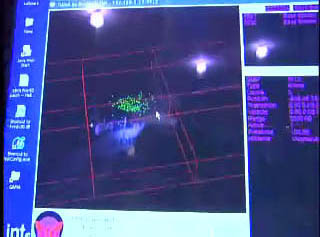Arts Research and the Role of Gaming
By Anna Lynn Spitzer
|
5.6.03 -- "I'm trying to initiate and aggregate arts research activities at UCI and enable faculty to engage with arts-based research," says Celia Pearce, Research and External Relations Manager for the New Media Arts layer at UCI. Pearce is working with UCI faculty NMA layer leader Simon Penny to launch an arts research program and enlarge its role within Calit².
So, one wonders, how would you define "arts research"? "I describe it as an approach to technology that is driven by cultural applications," explains Pearce. "What's unique is that, while it draws on entertainment-driven technology, it's not profit-motivated."
What artists do is envision the future, and imagination plays a key role in doing that, says Pearce. Although she believes that Calit² has a powerful mission to create the next generation of telecom and IT, she questions whether enough attention is being paid to applications. In fact, she's quite emphatic: "What are you going to do with ubiquitous bandwidth when it's a reality?" she asks. "Another way of putting it is: It's fine if the engine works, but will the car get me where I want to go?"
When talking about the New Media Arts layer -- which comprehends art, technology, and applications -- the discussion quickly turns to the subject of gaming. "The entertainment industry - I'm thinking of Sony and IBM - are on the threshold of producing the next generation of real-time 3-D gaming technology," says Pearce. "I applaud them for making games increasingly photorealistic, as we're seeing, but the fact is that game playing hasn't changed in five years! The questions we, as academics, should be asking are: What are the new game play paradigms we should be investigating? What would artists do if they had access to game development environments? How can you integrate fun and learning?"
These questions led to the formation of Calit²'s Game Culture and Technology Lab, led by director Robert Nideffer, UCI professor of Digital Arts; associate director Pierce; and Walt Scacchi of UCI's Institute for Software Research. As an important step supporting this activity, just 48 hours after submitting a proposal to curate and host a festival of independent and alternative games, called "ALT+CTRL" (like the keys on a desktop workstation) to UCI's Beall Center for Art and Technology, Pearce learned the proposal had been accepted!. The event, to be co-curated and organized by Nideffer, Antoinette LaFarge (assistant professor of Studio Art), and Pearce, will consist of several parts: a six-week exhibition, a conference that launches the exhibition (involving artists, members of the jury that select the works to be exhibited, and guest speakers), and online archive and printed catalogs.
"The idea," says Pearce, "is to create an event that will do for the game industry what the Sundance Film Festival does for the film world." Pearce maintains that gaming has become so successful that it's increasingly "risk-averse," and it's time for academics to shake things up, particularly by expanding the horizon of the types of games found to be interesting. "We need to go beyond fast-action, shoot-'em-up-type games," she says, "to develop better appreciation for games with more subtlety, games that are about ideas, for example. We need to think about designing for a broader range of game players. People often think computer games are just for adolescent males, but that's not the reality now, and certainly less so for the future."
The festival's Call for Participation will be circulated early in 2004, with the event launched during the fall of 2004 (keep your dial set to www.calit2.net for details). The jury will be drawn from game industry luminaries known for their innovation, game artists and theorists, and some of the leading digital and game art curators in the world. "It's important that we bring industry and academia together on this to have credibility in the art world," Pearce explains.
In a related project, the Game Lab, under the direction of Scacchi, is joining forces with Steve Cutchin and colleagues at the San Diego Supercomputer Center (SDSC) to develop the first phase of a "game research Grid." Their goal is to work with SDSC to test the TeraGrid, of which SDSC is one of four partners, as the highest-performance environment available for grid-based gaming. "Like the telephone and the fax machine," says Pearce, "the network exponentially increases in value when more and more nodes are added." Since the TeraGrid, has yet, has just four nodes, it's a good starting place for this kind of research. Several international partners have agreed to participate as this "Game Grid" expands.
|
This Game Grid is being enabled by the Butterfly Grid via butterfly.net in partnership with IBM. Butterfly.net describes its software as "transforming the fabric of the Internet into a high-performance video game machine." Game developers, publishers, and service providers use their software to develop, test, distribute, and maintain online games. Capable of supporting millions of players in expansive persistent-state worlds, the Butterfly Grid also supports multiple game devices, be they console, PC, or mobile. According to CEO David Levine, "Butterfly.net is interested in this research collaboration because the arena of online games with millions of players is still in its infancy. We're hoping Grid technology can unleash a wave of creativity and experimentation that will change the way we interact online for the better."
"Both UCI and UCSD campuses of Calit² expect to provide content for the game Grid," says Pearce. Pearce abides by what she calls the "constructivist model of gaming" where everyone can contribute his or her piece, enabling the game to be built literally while playing it. "We might learn better how to get along with each other through this type of collaborative, albeit playful, environment," she says pointedly, with a nod toward the front page of the Los Angeles Times whose headlines are frequented by just the opposite. Taking this philosophy one step further, the Game Lab team expects to create a front-end authoring system to enable people to create these kinds of game worlds, experiment with them, then change them.
Pearce notes that most of what personal computer systems today can do has been driven by the multimedia and gaming industries. "But industry typically targets no further out than the next holiday season," says Pearce. That can make Calit² engagement with industry difficult at times because they focus on the short term while academic researchers focus on the longer term.
"Now, though, might be a particularly good time to team with industry," says Pearce, "given the many influential industrial research labs - AT&T Bell Labs and Xerox PARC, to name a couple - that have so very sadly gone by the wayside. We'd love to work with industry in the arts and gaming world to help envision where technology is taking us and what the cultural implications are."



